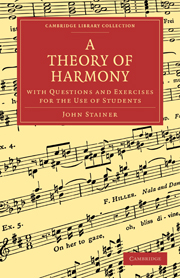Summary
32. Melody existed before Harmony (using both words in their modern sense); the sounds, therefore, which were first used for the purpose of harmonization must have been taken from the component parts of the melody, that is to say, from the Scale.
33. A Chord, therefore, is defined as “a combination of notes taken from a scale, or sometimes (but rarely) from two closely-allied scales.”
Further on will be found an explanation of a few chords derived from two closely-allied scales, see § 204.
Until the interval of a third is allowed to be the basis of all harmony, no theory of music can possibly be formed which will be true to facts. The old veneration for the perfections of the fourth and fifth, hardly yet extinct, helped to degrade thirds by calling them imperfect intervals; yet the greater number of those lovely chords which ravish us so much, and furnish us with an endless source of modulation (such as the chord of the diminished seventh and its inversions), contain neither the interval of a fourth or fifth between any of the component notes. All are thirds, or their inversions, sixths. If any interval ever deserved to be called perfect, it is the third. A major fifth by itself does not give us the means of judging whether we are in the major or minor mode. Except in barbarous music, the bare major fifth is never used, unless a composer, for the purpose of producing special effects, wishes to foster the impression of doubtfulness of mode. The fourth is less entitled to be called a harmony-producing interval than the fifth. […]
- Type
- Chapter
- Information
- A Theory of HarmonyWith Questions and Exercises for the Use of Students, pp. 15 - 20Publisher: Cambridge University PressPrint publication year: 2009First published in: 1876



